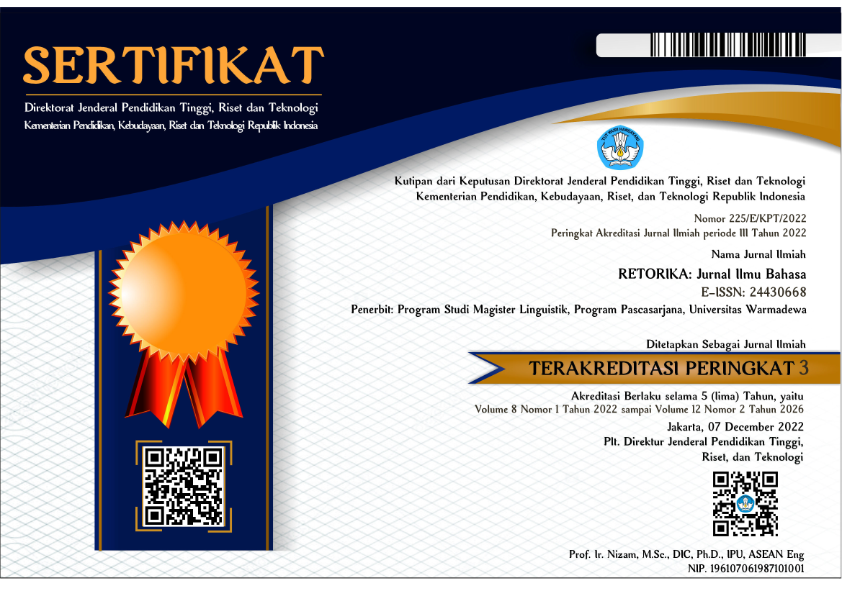Speech Function and Process in Fake News
Abstract
This paper deals with speech function and process found in the fake news in social media Twitter. The data used in this research are 66 clauses in the tweets about political sessions updated by the Twitter account @makLambeTurah and analysed qualitatively by applying Systemic Functional Linguistics theory. The result of the analysis shows that the most dominant speech function found in the fake news in the social media is the “statement†with relational process as the highest appearance. It means that the fake news writer, as the support team of the candidate, uses “statement†in sharing ideas, information, and issues to the readers and expects the readers to receive them, and also persuades the readers to believe and change their mind. The result also reveals that such speech function and process happen due to the relational status between the fake news writer and the candidates (politicians) he supports, that is PDIP, and the context of situation, that is in the Regional Election 2018.References
Arifuddin, M., & Sofwan, A. (2015). Speech Functions And Grammatical Patterns Realization In Conversation In The English Textbook. Lembar Ilmu Kependidikan: Journal of Educational Research, 44(1), 1–6.
Beville, B. (2017). Fake News & the Importance of Information Literacy. Retrieved from https://blogs.proquest.com/general/fake-news-the-importance-of-information-literacy/
Gil, P. (2019). What Is Twitter & How Does It Work? Retrieved from https://www.lifewire.com/what-exactly-is-twitter-2483331
Halliday, M. A. . (1994). An Introduction to Functional Grammar (Second). London: Edward Arnold.
Halliday, M. A. ., & Matthiessen, C. M. I. . (2004). An Introduction to Functional Grammar (Third Revi). London: Edward Arnold.
Halliday, M. A. ., & Matthiessen, C. M. I. . (2014). Introduction to Functional Grammar (fourth Rev). New York: Routledge.
Hantoro, J. (2018). Fadli Zon Laporkan Akun Ananda Sukarlan dan @makLambeTurah. Retrieved from https://nasional.tempo.co/read/1066106/fadli-zon-laporkan-akun-ananda-sukarlan-dan-maklambeturah
Kenzhekanova, K. K. (2015). Linguistic Features of Political Discourse. Mediterranean Journal of Social Sciences, 6(6), 192–199. https://doi.org/10.5901/mjss.2015.v6n6s2p192
Kimps, D., Davidse, K., & Cornillie, B. (2014). A speech function analysis of tag questions in British English spontaneous dialogue. Journal of Pragmatics, 66, 64–85.
Mantzarlis, A. (2017). There are now 114 fact-checking initiatives in 47 countries. Retrieved from https://www.poynter.org/fact-checking/2017/there-are-now-114-fact-checking-initiatives-in-47-countries/
Miles, M. ., Huberman, A. ., & Saldana, J. (2014). Qualitative Data Analysis: A Methods Sourcebook (Third). Los Angeles: SAGE Publications.
Siregar, U. N. (2017). Speech Function and Move in Rumah Uya Talk Show. International Journal of Language Learning and Applied Linguistics World, 16, 57–66.
Utama, L., & Bestari, N. P. (2018). Twitter, Media Sosial Penyebar Hoax Terbesar. Retrieved from https://www.viva.co.id/arsip/1014660-twitter-media-sosial-penyebar-hoax-terbesar
Copyright (c) 2019 RETORIKA: Jurnal Ilmu Bahasa

This work is licensed under a Creative Commons Attribution-ShareAlike 4.0 International License.
This journal provides immediate open access to its content on the principle that making research freely available to the public supports a greater global exchange of knowledge.
All articles published Open Access will be immediately and permanently free for everyone to read and download. We are continuously working with our author communities to select the best choice of license options, currently being defined for this journal as follows: Creative Commons-Non Ceomercial-Attribution-ShareAlike (CC BY-NC-SA)
 Abstract viewed = 759 times
Abstract viewed = 759 times
 PDF downloaded = 296 times
PDF downloaded = 296 times

2.png)














